By Theme:Arts and Literature | Campus Sustainability | Community Perspectives | Development | Economic Analysis | Ecosystem Analysis | Education | Energy | Environmental Justice | Food Systems | Geology of the Watershed | Green Architecture | Green Business | History of the Watershed | Invasive Species | Land Use Patterns | Public Policy | Recreation | Transportation | Water Quality
Development
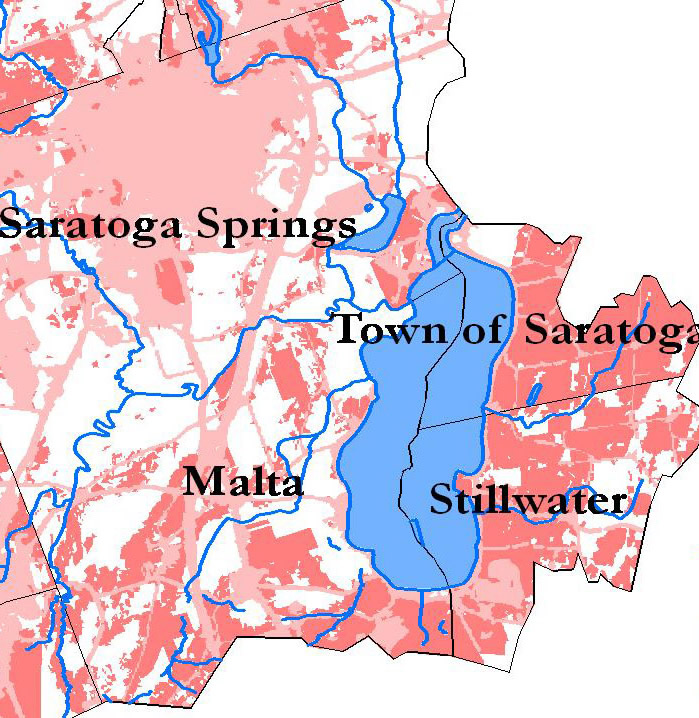 Potential Development in the Saratoga Lake Watershed
Potential Development in the Saratoga Lake Watershed
Betsy Quentin and Leigh Siegwarth (2007)
We explored where development is likely to occur in the Saratoga Lake Watershed. Using Geographic Information Systems (GIS) to compile zoning maps, land use maps, use schedules, and comprehensive plans, we projected areas that are prone to development. We conclude there is significant build-out potential in the watershed.
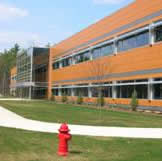 Projects and Perspectives that are Shaping Smart Growth in Malta, New York
Projects and Perspectives that are Shaping Smart Growth in Malta, New York
Sophia Wiley (2008)
I examined the prospects for smart growth in Malta, New York by conducting analyses of projects Steeplechase at Malta and Luther Forest Technology Campus, and by conducting interviews with elected officials and stakeholders in Malta. My research has found that these projects and envisioned plans for growth simultaneously complement and deviate from the principles of smart growth.
Full report is not available. Please contact Bob Turner for more information.
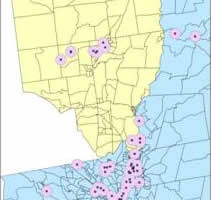 Environmental Justice Along the Hudson River
Environmental Justice Along the Hudson River
Katarra Peterson ’09, Mary Rynasko ’11 and Rik Scarce, Associate Professor of Sociology (2008)
“Environmental justice” is an area of sociological study combining race, class, and the environment. It hypothesizes that minorities and the poor are disproportionately burdened by environmental hazards. The goal of this project is to explore how environmentally just or unjust the Hudson River region is. The research involves using geographic information systems (GIS) and U.S. Census Bureau data sets to map the locations of polluting facilities and the demographics of the neighborhoods around them. Results are organized by facility type and have thus far indicated that the environmental justice hypothesis is accurate for the Hudson region.
 The Capacity for Smart Growth in the Saratoga Lake Watershed: A Study of the Local
Planning Process
The Capacity for Smart Growth in the Saratoga Lake Watershed: A Study of the Local
Planning Process
Rose Anderson-Gips and Amanda Peterson (2009)
Are municipalities in rapidly growing Saratoga County managing development to minimize environmental impact? We reviewed comprehensive plans and surveyed and interviewed planning board members in twelve municipalities within the watershed and found a strong commitment to most smart growth goals, though a limited interest in regional planning.
Full report is not available. Please contact Bob Turner for more information.
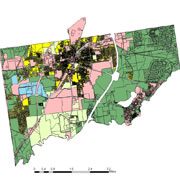 A Watershed Approach to Land Conservation in the City of Saratoga Springs, New York
A Watershed Approach to Land Conservation in the City of Saratoga Springs, New York
Dan Haro and Carolyn Raider (2010)
Saratoga is New York’s fastest growing county. Population increase leads to residential and commercial development, resulting in habitat degradation and fragmentation. Saratoga Springs provides conservation through its zoning ordinance, "the Green Belt." Our study identifies high priority sites to protect within Saratoga’s “Green Belt” conservation zone. We identify the least developed watersheds as well as watersheds with the highest percentage of forest, wetland, open water, and grassland/shrub habitats. We recommend replacing the current parcel-based approach to conservation with a more relevant and environmentally successful watershed approach. We also recommend additional protection for watersheds with a low percentage of development.
Full report is not available. Please contact Josh Ness for more information.
 Implementation of Rain Gardens as Alternative Stormwater Management Technique in the
Saratoga Lake Watershed
Implementation of Rain Gardens as Alternative Stormwater Management Technique in the
Saratoga Lake Watershed
Eli Dibner-Dunlap and Vince Weeks (2010)
Rain gardens are modeled to reduce stormwater runoff by more than a third. Within the Saratoga Lake Watershed, 88% of existing residences contain soils suitable for rain garden implementation. Government regulation or economic benefit is necessary to incentivize developers. Successful implementation examples are required to convince engineers to implement rain gardens.
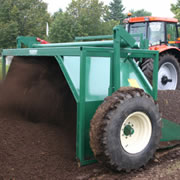 Composting at Skidmore: Turning our Waste into a Resource
Composting at Skidmore: Turning our Waste into a Resource
Will Coffey and Nadine Dodge (2010)
Skidmore College produces a substantial amount of organic waste in the form of food scraps, horse manure, and lawn maintenance byproducts that present both economic and environmental concerns to the College. We conducted a comprehensive study to ascertain how these wastes can be turned into a valuable economic and environmental resource through composting. After completing a study of composting at peer institutions, analyzing available composting technologies, and conducting a cost-benefit analysis, we determined that a windrow composting system will be the most cost-effective waste management system for Skidmore. The final result of our project is a detailed proposal that outlines how such a system can be implemented.
 Shades of Green: The Environmental Sustainability of New Home Design and Build in
the Saratoga Springs Region
Shades of Green: The Environmental Sustainability of New Home Design and Build in
the Saratoga Springs Region
Phoebe Gallagher and David Ornvold (2010)
In the United States, homes account for twenty percent of energy consumption. Saratoga County is one of the most rapidly growing in the state of New York. This growing population will need new homes. How homes are built now will directly effect the environmental sustainability of our community. We interviewed architects and builders in the region to see how sustainable their work is and what deters them from being more efficient and sustainable. Cost and lack of knowledge were found to be the primary hurdles.
Full report is not available. Please contact Karen Kellogg for more information.
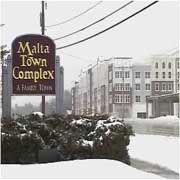 Why Don't Communities Choose Smart Growth? A Case Study of Public Deliberation over
Planning Decisions in Malta, NY
Why Don't Communities Choose Smart Growth? A Case Study of Public Deliberation over
Planning Decisions in Malta, NY
Nicholas Liu Sontag and Andrew Noone (2011)
If sprawl is unsustainable, why do so few growing communities choose smart growth strategies? We assess Malta’s debate over planning and growth to analyze the quality of traditional forms of public deliberation. We also explored the potential of visual assessment forums to improve the quality of public deliberation on planning decisions.
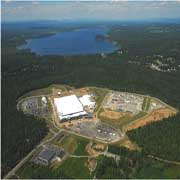 Balancing Economic Growth with Environmental and Social Concerns: Evaluating SEQRA
Through a Case Study of Global Foundries
Balancing Economic Growth with Environmental and Social Concerns: Evaluating SEQRA
Through a Case Study of Global Foundries
Korena Burgio and Evan Caster (2011)
New York State sought to revitalize its economy by attracting semiconductor manufacturing to the Upstate region by competing globally for Global Foundries' newest microchip fabrication facility, Fab 8. Our analysis explores the role New York’s State Environmental Quality Review Act (SEQRA) in evaluating the comprehensive economic, environmental, and social impacts associated with Fab 8’s construction and operations in Malta, NY.
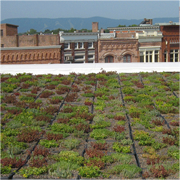 Green Roofs in the Saratoga Lake Watershed: Sedums of Change
Green Roofs in the Saratoga Lake Watershed: Sedums of Change
Isobel Flake and Devin O'Donoghue (2011)
Our project examines the perceived obstacles and benefits of green roof implementation. Through case study analyses of Wilton and Skidmore College, we evaluate the financial implications of green roofs, and their influence on stormwater management, carbon sequestration, and energy efficiency.
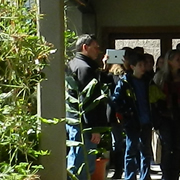
Saratoga’s First Green Home Tour: A Social Experiment
Rene deJongh, Melissa Green, and Stephanie Seidmon (2013)
As an individual, your single most significant impact on the natural environment is your choice of home and behaviors within the home. As a result, the residential sector in the United States accounts for 40% of our carbon emissions. If energy efficient homes have a smaller environmental impact and save the consumer money, why don’t more people build green homes? In this study we explored the perceptions and behaviors of Saratoga County residents about building green and retrofitting homes through interviews and surveys and how a Green Home Tour could serve as a method of education to spread awareness of green building.
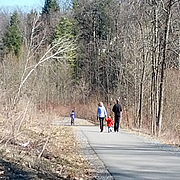 Grand Plans, Trails to Nowhere: An Analysis of Multi-Use Trails in Saratoga Springs
Grand Plans, Trails to Nowhere: An Analysis of Multi-Use Trails in Saratoga SpringsNate Blanks, Sarah Marks, and Dan Raudonis (2013)
The trail network in Saratoga Springs is underdeveloped and despite numerous plans a cohesive trail network is still far from being a reality. We assess the factors that affect trail creation through historical and first-hand research. Key barriers to trail implementation include funding, government will and communication. Ultimately, we make recommendations for how to improve future trail efforts in the area, including a current plan to create a 10-mile network of trails.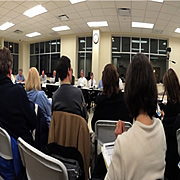 Economic Growth, Politics, and Comprehensive Planning
Economic Growth, Politics, and Comprehensive PlanningJosh Inaba, Katherine Rosman, and Leslie Velasquez (2014)
Saratoga Springs is challenged with planning for future development that balances growth and conservation of natural resources. We conducted a historical and qualitative analysis of the city’s comprehensive plans over the last 50 years and interviewed various stakeholders, and studied how the theory of sustainable development has been implemented. Despite conflicts between competing interests, the outcome of comprehensive plans and the work of local politicians have balanced economic, sustainability, and social goals.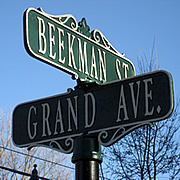 The Buzz on Beekman: An examination of New Urbanism at the neighborhood level
The Buzz on Beekman: An examination of New Urbanism at the neighborhood levelKate Johnson, Emily Culbert, and Sarah Arndt (2014)
Examining urban revitalization at a neighborhood level provides a manageable scale to assess whether development fosters relationships, builds community, and is sustained through multiple generations. We used the Beekman Street neighborhood on the west side of Saratoga Springs as a case study. Residents valued three key tenets of New Urbanism – walkability, mixed-use, and density – but were concerned with potential negative effects of increased commercialization.Full report is not available. Please contact Karen Kellogg for more information.
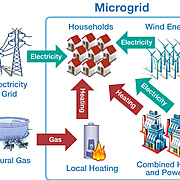 Tackling the Challenge of Smarter Energy Design
Tackling the Challenge of Smarter Energy DesignKyle Downey, Sam Holmberg, & Michaela Kerxhalli-Kleinfield (2016)
Traditional power generation and distribution via the macrogrid is outdated, inefficient, and susceptible to outages from natural disasters. Microgrids are localized grid systems capable of producing energy using small-scale sources. We analyzed microgrid development across NY State. Functionality, reliability, and cost-effective design were more important to participating communities than environmental considerations. Obstacles include financial and technological challenges along with lack of coordination and prior experience.